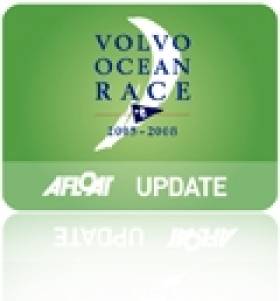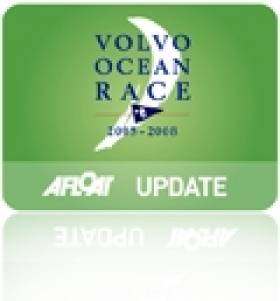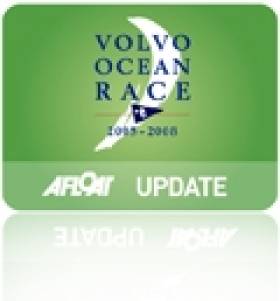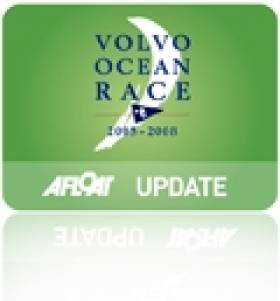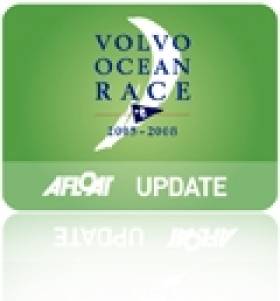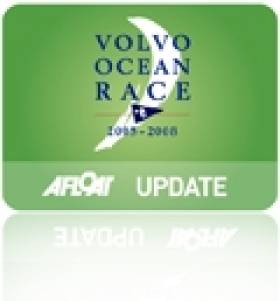Displaying items by tag: Sanya
Disciplinary Rule 69 Change Proposed at ISAF World Conference
In the midweek sessions at the ISAF World Conference in Sanya, China, the various committees are working on over 300 submissions suggesting changes to ISAF regulations, Racing Rules of Sailing (RRS) and Offshore Special Regulations(OSR). Some of these submission pass through more than one committee picking up recommendations as they go along. The submissions and their recommendation are considered by the final arbiter, the ISAF Council, which will determine at the end of the week whether submissions should be approved, rejected or deferred. This year is the final year for submissions that can alter the next iteration of the RRS, due January 1 2017, hence the large number. One proposal that is garnering attention is changes to Rule 69, the disciplinary rule. The changes propose extending the provisions of Rule 69 to “support persons” so that a competitor can be penalised over the adverse behaviour of a coach or parent or similar. The Working Party that submitted this proposal considers it so important that it is suggesting its immediate introduction – ie January 1 2016 instead of the following year.
ISAF’s plethora of classes (>100) continues to grow with the recommendation that the RS Aero, Fareast 28R, VO65, Kite Twin Tip Freestyle, Kite Foil, and Nacra F20 Carbon be added to the family.
Winds Of Up To 30 Knots Forecast For Sanya Departure
#vor – Volvo Ocean Race's six-strong fleet heads out towards Auckland from Sanya for Leg 4 on Sunday with some big calls to make in the latest instalment of a marathon offshore contest.
Charles Caudrelier's (FRA) Dongfeng Race Team have their noses in front by a single point after the stage from Abu Dhabi to Sanya, but know that they could so easily follow the example of Team Brunel (Bouwe Bekking/NED), who could only muster fifth place on the leg to China after winning the previous one.
The Chinese team, which became the first from the world's most populous nation to win a leg in the 41-year-old race last month, have yet to announce their crew plans for the 5,264-nautical mile trip to Auckland, New Zealand.
These will be unveiled on Friday (February 6) and it will be fascinating to see how many changes they make to a crew which is performing so surprisingly well.
Chris Nicholson (AUS) and several members of the Team Vestas Wind crew, whose boat was badly damaged on a reef in the Indian Ocean on November 29 during Leg 2, will watch the departure in Sanya.
The skipper from Lake Macquarie, New South Wales, reported on Thursday that Vestas Wind had arrived at the Persico yard in Bergamo, Italy, and the first stages of the rebuild were now underway with a hoped-for return to the race in June.
Meantime, the latest round of the In-Port Race Series - this one named the Team Vestas Wind In-Port Race - will be held on Saturday with Team SCA (Sam Davies/GBR) aiming to continue their good form following victory in Abu Dhabi.
Volvo Ocean Race Leg Three Sets Up For Thrilling Finish in Sanya, China
#vor – A thrilling finish looks to be in store for Leg 3 of the Volvo Ocean Race after the chasing pack made big inroads into Dongfeng Race Team's once huge lead early on Sunday with just over 24 hours to sail to the finish in Sanya.
Charles Caudrelier's (FRA) crew led by more than 106 nautical miles (nm) approaching the Malacca Strait but gradually their advantage has been clawed back with under 350nm left of this fascinating stage from Abu Dhabi to Sanya on the southernmost tip of China.
Understandably, the French skipper and his team have been feeling the pressure as the chasing pack led by Abu Dhabi Ocean Racing (Ian Walker/GBR) threatened their hopes of becoming the first Chinese-backed team to win a leg in offshore sailing's most prestigious round-the-world race.
Victory in the 4,670nm stage, which started on January 3 in Abu Dhabi, would also put Dongfeng Race Team top of the overall standings on five points ahead of Abu Dhabi Ocean Racing and Team Brunel who won Legs 1 and 2 respectively.
"Onboard Dongfeng we must stay concentrated ... the finish line is still a long way away," Caudrelier had warned in a blog from the boat as the fleet headed towards the Vietnamese coast before the weekend.
At 1240 UTC on Sunday, they had a lead of 34nm over Leg 1 winners Abu Dhabi Ocean Racing with Team Alvimedica (Charles Enright/USA), MAPFRE (Xabi Fernández/ESP) and Team Brunel (Bouwe Bekking/NED) hot on their heels too within 50nm of the Dongfeng boat.
Team SCA (Sam Davies/GBR) have been making good gains too, lying 69.2nm behind the leaders.
Game face: Justin Slattery is focused on closing out a podium place on Leg 3. #inabudhabi #goazzam #VolvoOceanRace pic.twitter.com/ymSXZzLAWk
— AbuDhabiOceanRacing (@ADORlog) January 25, 2015All the fleet had been slaloming back and forth with gybe after gybe to avoid the numerous obstacles, including a series of near misses with fishing vessels and their nets just off the Vietnamese coast.
Walker described that process during Saturday night as "possibly the single hardest night of the race" while Enright went further: "It was the most intense night of sailing of my entire life."
The sailors are heading for an amazing welcome in Sanya. The Race Village opened on Saturday to large crowds and is sure to repeat last edition's (2011-12) fantastic receptions for the fleet no matter what time of day or night they arrive.
VOR Update: Sanya Back On Route, Assembly Time For VOR 65
#VOR - The Chinese port of Sanya is the latest addition to the route for the next Volvo Ocean Race.
The sunny city in southern China - and the "best kept secret in sailing" according to Volvo Ocean Race CEO Knut Frostad - returns to the race with previously announced addition Lisbon after its debut hosting in the 2011-2012 edition,
"We were given an exceptional welcome by Sanya in the last edition, with the stopover providing a unique take on the race, and it's gratifying to know we will be back to build on our legacy," said Frostad.
Sanya also fielded a team backed by Discover Ireland in the last edition of the global yachting challenge - though they dealt with some misfortune only hours into the first leg of the race, suffering very serious hull damage as seen HERE.
Meanwhile, progress on the new design VOR 65 that will be raced in the 2014-15 Volvo Ocean Race made a great leap forward this week as the hull completed at Persico in Italy and the decking built at Multiplast in France made their way to Green Marine in Southampton for assembly.
The video above also includes a sneak peak at a mockup of the completed design that will hopefully take to the water in the coming months.
New Rig For Sanya (Photos)
#VOLVOOCEANRACE – The Discover Ireland backed Team Sany entry in the Volvo Ocean Race has been busy discovering Madagascar over the past few weeks as they awaited new rigging for their stricken yacht that pulled into the port of Talanero for emergency repairs before Christmas. Now it looks like they're getting ready to leave. Fingers crossed. See below photos attached from TEAM SANYA action today in Madagascar. SEE PHOTOS BELOW.
'The day we thought would never come has arrived', said Nick Bice, Team Sanya shore team manager. 'Today after nearly 3 weeks, the rig is going back in. Some of the sailing team arrived today and immediately got to work in preparing the boat to leave once the sea trials are done. The tentative plan is to step the rig today with sea trials planned all day tomorrow and on the Friday if needed. Mast going in now...'
New Year, New Rigging for Team Sanya
#VOLVOOCEANRACE – A pre-Christmas rig failure on board the Discover Ireland backed entry 'Team Sanya' in the Volvo Ocean Race continues to thwart the Chinese-Irish sailing team. The crew are hopeful now of fitting new rigging to the 70-foot ocean racer today at their emergency stop port of Madagascar. The yacht has yet to complete any of the legs of the race that started in November from Alicante, Spain.
Former race winner Mike Sanderson, Skipper and CEO of Team Sanya, issued an update on New Year's Eve stating that Team Sanya is now aiming to 'resume racing as soon as the new rigging is in place' and they hope to complete the first part of Leg Two of the 2011-12 Volvo Ocean Race.
The team suffered from a rigging failure on 19th December when they were leading the fleet during Leg Two and had to suspend racing and make an emergency stop in Fort Dauphin, a port in the South East of Madagascar.
Since then the team have been working flat out to make the necessary repairs as, due to the state-of-the art rigging used by the team, the whole side rigging system has had to be changed and the replacement rigging has now been created by Future Fibres. This rigging equipment left with shore team members from Valencia on 30th December and is due to arrive into Fort Dauphin today for the final preparation and curing process to begin.
The sailing team will gather in Fort Dauphin over the next few days and, along with the shore crew, they will step the re-built rig, tune and then sea-trial, with the aim of being able to resume racing on or around the 6thJanuary. The team is aiming to complete the first section of Leg Two that will take them to the safe haven port. By completing this part of Leg Two they are then entitled, under the Notice of Race rules, to claim average points for the second short stage of Leg Two, the InPort race in Abu Dhabi and the first stage of Leg Three.
Team Sanya is then forced by race rules to await for the fleet to return to the safe haven port during Leg Three and will then re-join the race into their home part of Sanya.
Mike Sanderson, commented on this latest decision:
"The rigging failure was a massive disappointment to us as a team. We were having a great leg and felt that we were showing for the first time what this team has the potential to deliver given an opportunity opening up for us. It has taken quite some time to come to terms with this second blow to our campaign but that's all part of what can happen during a Volvo Ocean Race and we are more determined than ever to get racing again.
We have spent considerable time assessing the options and weighing up what might be seen as a relatively short term gain of completing this leg against the need to ensure the boat and team are 100% ready and race fit for Leg Three and onwards. After discussion with our key sponsors, we made the decision to do everything we can to complete this part of Leg Two and maximize the points we can gain which could be of value to us later in the race. We are still very dependent on everything going right with the application of the new rigging down in Madagascar but very hopeful that we can resume racing as soon as possible"
Discover Ireland's Volvo Entry 'Sanya' Makes Landfall in Madagascar
#VOLVOOCEANRACE – The Discover Ireland backed entry in the Volvo Ocean Race Team Sanya - the sailors and the boat - have all safely arrived in Talañero (sometimes called Taolagnero) in Madagascar, an unexpected pitstop in leg two due to rigging problems. The crew is cleaning the boat and doing some work to make everything secure. Communications is a little difficult with the crew as they have no mobile phones with them nor laptops. Skipper Mike Sanderson has gone off to basic supplies (like phones, sim cards and flip flops!
View Larger Map
Rig Damage Forces Chinese-Irish Yacht Sanya Ashore
#VOLVOOCEANRACE – Team Sanya is heading for shore again, the second time in as many legs. This time the Discover Ireland backed yacht in the Volvo Ocean Race has suffered rigging damage.
The 70-foot Chinese-Irish entry reported into race headquarters early this morning that they had suffered damage during the night to part of their rigging (D2 intermediate shroud) and are having to head to a port in Southern Madagascar in order to assess the damage and make a repair plan. All the team are safe and well, no one has been injured and the race boat is fully under control with the mast still upright and the boat still able to sail to shore.
Mike Sanderson, CEO and Skipper of Team Sanya, advised on the situation and background to the incident:
"We were just out of the major breeze and changing sails from the J4 to the fractional zero and were in wind speeds of around 12-14 knots when we noticed a vital piece of rigging loose from the mast (D2 shroud). We had just been through an awesome night's racing and were totally hauling and making massive gains so we were very upbeat about our progress. The weather was turning for the better and so we were happy in our decisions and general progress. We had been due to tack an hour earlier in the darkness but had delayed that given the conditions and for sure, if we had done that, the rig would have fallen over the side. As you can imagine we are totally gutted and can't quite believe this has happened when everything was going so well."
The team had now got the boat tidied up and they have secured the rig in a safe manner as they make their way towards a port in Southern Madagascar. The shore team and Volvo Ocean Race officials are assessing the port options and are in constant contact with the team on the boat.
Volvo Ocean Racer Sanya Hits the Water Again
#SANYA – Today Sanya Lan, the Volvo Ocean entry backed by Discover Ireland touched the water of the Cape Town this evening and is now tied up next to the team base, a momentous day for the team after retiring from Leg One nearly a month ago. The plan is to step the mast in the boat as soon as possible and then gather for a well-deserved team barbeque.
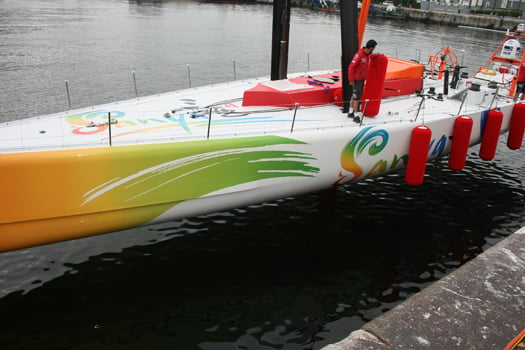
Sanya hits the water in Capetown
Team Sanya Hitches a Ride to Capetown (Photo)
#SANYA– Definitely not as intended but neverthless on her way to Cape Town as our picture shows. The Discover Ireland backed Sanya entry in the Volvo Ocean Race has been successfully repaired and is ready to joing the other six yachts in the fleet. The 70-foot yacht suffered hull damage only hours into the race. Still to arrive is Puma, the third boat in the fleet to have suffered damage in the first leg.
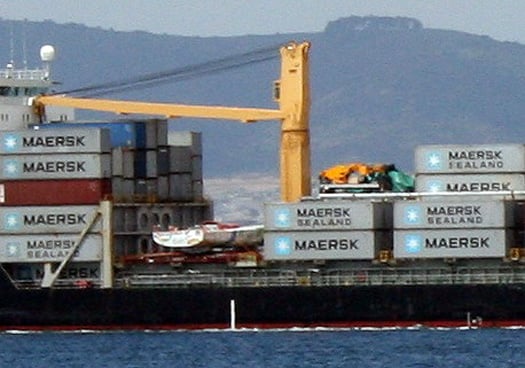
Afloat again and heading for Capetown. Team Sanya is repaired and spotted on a cargo ship


























